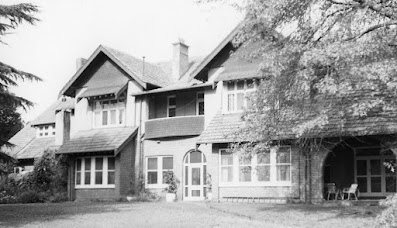Miss Fanny Dango
State Library of Victoria Image H85.73/6
Report of the marriage between Sam MacKay and Fanny Dango
The Argus, December 1, 1910 http://nla.gov.au/nla.news-article10481561
Sam died May 11, 1923. According to his obituary, published in Pastoral Review, June 16 1923 (see here). Sam MacKay, was born in 1864 in Mount Gambier. He left school at 13 and did some cattle droving, until he decided to move to northern Western Australia where he worked in the pearling industry. Later on his father and two uncles purchased the one million acre Mundabullangana Station, east of Roebourne. By 1903, when his father died, he bought the Station outright. In 1905, he purchased Melville Park at Berwick from James Gibb and lived there until 1912. MacKay built a mansion on the property around 1907. The building was designed by Rodney Alsop and is listed on the Victorian Heritage Register, where it is described as a two-storey red brick example of the English vernacular style with some reference to the Queen Anne style. It has also been described as being in the Arts and Crafts Style. The Melville Park property was later renamed Edrington, and the mansion is now part of a retirement village. It is pictured below.
MacKay's obituary ends with Although the late Mr. Mackay was a well-known pastoralist, he was better known as a breeder and lover of thoroughbred horses, and his colours were a familiar sight on the chief racecourses in Australia.
In 1892, Sam had married Florence Gertrude Taylor in Western Australia. Florence was from Yangdine, near York in Western Australia. They had three children - Elsie Gertrude (born 1893 in Roebourne, W.A., died in Melbourne in 1963); Marjorie (born and died 1895) and Samuel Keith (1900 - 1924). You can read about the family here, in an article entitled The Tragedies of the MacKays in the Sunday Times, July 27, 1924. Keith had recently died in an aeroplane accident at near Port Headland when the article was written. Sam and Florence were divorced in August 1910, a few months before his marriage to Fanny. Sam and Fanny then had one son, Peter Angus, born in 1911.
Report of Sam's divorce from his wife Florence.
Weekly Times August 13, 1910 http://nla.gov.au/nla.news-article221768766
Above is an account of the MacKay divorce from the Weekly Times. As Sam married Fanny a few months later in the November, you would have to assume that they were already acquainted whilst the divorce proceedings were being heard.
Who was exotically named Fanny Dango? Fanny was born in 1878 as Fanny Rudge, to Henry and Elizabeth Rudge of Birmingham. She had four sisters who also became actresses - Letitia (stage name Letty Lind), Sarah (stage name Millie Hylton), Elizabeth (stage name Adelaide Astor) and Lydia (stage name Lydia Flopp) and two brothers who followed their father's career as a brass founder.
Fanny was in Australia working in various States on a frequent basis between 1900 and 1910, according to newspaper reports at the time. If you put her name into Trove, you will get many results.
A report of one of Fanny's performances.
The Age September 11, 1907 http://nla.gov.au/nla.news-article205010741
Fanny died July 15, 1972 at the age of 91. She is buried at the Brighton Cemetery, with her husband Sam; her son Peter who died December 12, 1951 and Sam’s daughter, Elsie, who died February 6, 1963. Elsie MacKay was an actress, who had married British and Hollywood film star, Lionel Attwill. She was his second wife and after their divorce, he married Louise, the divorced wife of General Douglas MacArthur.
Death of Lionel Attwill, the husband of Sam MacKay's daughter, Elsie.
Daily Telegraph, April 24, 1946 https://trove.nla.gov.au/newspaper/page/27446481
Acknowledgement
I am indebted to Bob Flavell of the Edrington Park History Group for telling me about Fanny Dango.
Footnote
When I wrote this article in May 2018 this link to the information about the Rudge sisters was working but now (May 2021) it no longer works -












